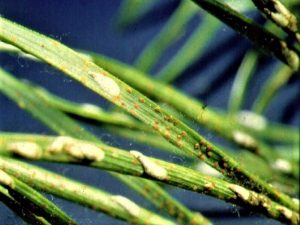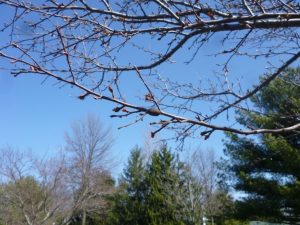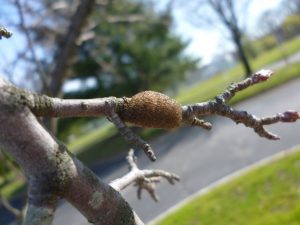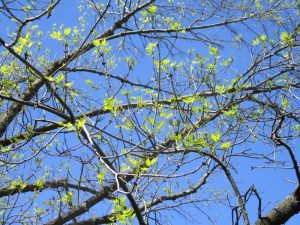Soft Scale Species Controls (June & July): Compared to armored scales, the soft scales are relatively easy to suppress with either contact sprays or systemic treatments. Some of the common landscape soft scale species in NJ include calico, Fletcher, Indian wax, cottony maple, cottony camellia, spruce bud, European fruit lecanium, pine tortoise, striped pine, magnolia, & tulip tree. Although large soft scale adult females are more difficult to control, the immature nymphs are often vulnerable to sprays when good coverage is achieved. However, there are some species that have proven to be more challenging to control. Two good examples include the calico scale & Indian wax scale species. Horticultural oil sprays are often recommended to control immature scale nymphs, but sometimes against the calico & Indian wax species the efficacies are less consistent. This blog will first review soft scale management options & then show photographs & discuss the life cycles of the following soft scale species with crawlers emerging during June & July: (1) Indian wax, (2) calico, (3) cottony camellia, (4) spruce bud, & (5) Fletcher.
Some Key Armored Scales & Crawler Emergence
A Large-Scale Dilemma:

Drawing shows a shrinking female armored scale laying eggs. Waxy covers of each of the 3-instars are pushed above the other. Crawlers emerge from the female cover through the one-way flap. (Drawing Credit: John Davidson, Univ. of MD)
Undoubtedly many arborists, landscapers, nurserymen, and golf course superintendents would agree that effectively controlling scale insects is one of the more frustrating pest management challenges encountered. Of the half-dozen major families of scale insects common in the urban landscape, the armored scales are the most troublesome. With their protective waxy covering, armored scales are considerably less susceptible to various insecticide spray treatments.

Reddish colored crawlers of Pine Needle Scales emerging out from under female waxy covers. (Photo Credit: Ohio State Coop. Ext.)
Historically, many pesticide spray applicators fail to achieve satisfactory controls because they do not have the time or inclination to apply sprays during the scale crawler emergence periods. To complicate matters, the crawler periods for the various armored scale species are quite variable. Furthermore, the improper timing of long residual pyrethroid insecticides can virtually eliminate important parasitoid bio-control activity and hence, often encourage scale infestations. The intention of this blog is to stress the importance of properly timed treatments to achieve better management of scale insects. This is especially true when attempting to control armored scales.
Despite the complications stated above, fortunately some relatively newer insecticides have given improved abilities for scale controls. These newer materials & the life cycles of 5-armored scale species will be covered in this blog. The scales covered include: 1-Euonymus scale; 2-Cryptomeria scale; 3-Japanese maple scale; 4-White Prunicola scale; & 5-Juniper scale.
Landscape Pest Notes: Some Late-Spring Insects (Part 2)
Since there are still over 4-weeks before the official start of summer, the accumulation of growing-degree-days (GDD) will continue to accelerate over the next several weeks. Many of our landscape insect pests will be rapidly emerging and be entering their best control windows before they potentially cause feeding symptoms. This writing contains part 2 of 2 parts of only a handful of the many late spring landscape insect pests that require monitoring. Some could more properly be called mid-spring pests, especially in southern NJ. Those included within part 2 of this blog are: Taxus mealybug; Boxwood leaf miner; Aphid species and Bronze birch borer.
Landscape Pest Notes: Some Late Spring Insects (Part 1)
Since there are still nearly 5-weeks before the official start of summer, the accumulation of growing-degree-days (GDD) will continue to accelerate over the next several weeks. Many of our landscape insect pests will be rapidly emerging and be entering their best control windows before they potentially cause feeding symptoms. This writing contains part 1 of 2 parts of only a handful of the many late spring landscape insect pests that require monitoring. Some could more properly be called mid-spring pests, especially in southern NJ. Those included within part 1 of this blog are: Four-lined plant bug; Douglas-fir needle midge; Pine needle scale; & Elongate hemlock scale.
Landscape Pest Notes: Some Mid-Spring Insects/Mites
As we enter the last week of April, many of our mid-spring landscape insect/mite pests continue to awaken & cause feeding symptoms on our ornamentals. This blog only talks over some of the typical mid-spring pests that plague our landscapes. Those discussed within include: Southern Red Spider Mites; Gypsy Moths; Evergreen Lace Bugs (e.g., rhododendron, azalea, & andromeda lace bugs); Nantucket Pine Tip Moth; Birch Leaf Miner; Hemlock Woolly Adelgid; Plant Leaf Galls (eriophyid mites).
Eastern Tent Caterpillar: The Landscape Harbinger of Spring
Throughout much of NJ during this week, the growing degree days (GDD) will be increasing consistently. By the end of the week, many areas will exceed 90 GDD, which means the eastern tent caterpillars will begin to hatch. Not all eggs will hatch at once since a staggered hatching period will potentially increase survival rates if the weather happens to cool again.
The photographs of the eastern tent caterpillar’s life cycle included in this blog were all taken during the spring of 2016 at the same site in Freehold, NJ. They are placed in chronological order covering a time span of 10 weeks from 1st egg hatch on 3/23/16 to late pupation on 6/2/16. In 2016, central NJ experienced a relatively warm early spring that enabled the speedy first hatching.

Date: 3/23/16 (No hatch). Do you see it? One inch long Tent Cat egg mass overwinters encircling 2-3 year old twigs. (Photo Credit: Steven K. Rettke, Rutgers Coop. Ext.)

Date: 3/23/16 (No Hatch). Close-up of the Tent Cat egg mass. It has the appearance & feel of styrofoam. (Photo Credit: Steven K. Rettke, Rutgers Coop. Ext.)



